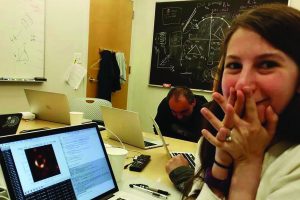 The world has laid eyes on an image a black hole that previously was considered to be unseeable. The first visualisation of a black hole is likely to revolutionise our understanding of one of the great mysteries of the universe. And the woman whose crucial algorithm helped make it possible is just 29 years old.
The world has laid eyes on an image a black hole that previously was considered to be unseeable. The first visualisation of a black hole is likely to revolutionise our understanding of one of the great mysteries of the universe. And the woman whose crucial algorithm helped make it possible is just 29 years old.
Katie Bouman was a PhD student in computer science and artificial intelligence at the Massachusetts Institute of Technology (MIT) when, three years ago, she led the creation of an algorithm that would eventually lead to an image of a supermassive black hole at the heart of the Messier 87 galaxy, some 55m light years from Earth, being captured for the first time, media reports said.
Bouman was among a team of 200 researchers who contributed to the breakthrough, but on Wednesday, a picture of her triumphantly beaming as the image of the black hole materialised on her computer screen went viral, with many determined that Bouman’s indispensable role was not written out of history — as so often has been the case for female scientists and researchers, reported Guardian.
The data reportedly used to piece together the image was captured by the Event Horizon telescope (EHT), a network of eight radio telescopes spanning locations from Antarctica to Spain and Chile. Bouman’s role, when she joined the team working on the project six years ago as a 23-year-old junior researcher, was to help build an algorithm which could construct the masses of astronomical data collected by the telescope into a single coherent image.
Though her background was in computer science and electrical engineering, not astrophysics, Bouman and her team worked for three years building the imaging code. Once the algorithm had been built, Bouman worked with dozens of EHT researchers for a further two years developing and testing how the imaging of the black hole could be designed. But it wasn’t until June last year, when all the telescope data finally arrived, that Bouman and a small team of fellow researchers sat down in a small room at Harvard and put their algorithm properly to the test, the Guardian report pointed out.
With just the press of a button, a fuzzy orange ring appeared on Bouman’s computer screen, the world’s first image of a supermassive black hole, and astronomical history was made. In a post on social media, Bouman emphasised the collaborative efforts that had made the imaging of the black hole possible.
“No one algorithm or person made this image, it required the amazing talent of a team of scientists from around the globe and years of hard work to develop the instrument, data processing, imaging methods, and analysis techniques that were necessary to pull off this seemingly impossible feat,” said Bouman.
Scientists react
Indian scientists have praised the compilation of the first-ever real images of a blackhole as an “extraordinary feat” that sheds more light on the mysterious, warped region of the space-time fabric and how galaxies like our Milky Way evolve over time. Blackhole, an object with such strong gravity that not even light can escape it, has fuelled human imagination and inspired numerous sci-fi movies and literature for generations.
Researchers at The Event Horizon Telescope (EHT) — a planet-scale array of eight ground-based radio telescopes forged through international collaboration — unveiled the first direct visual evidence of a supermassive blackhole and its shadow. The image reveals the black hole at the centre of Messier 87, a massive galaxy in the nearby Virgo galaxy cluster.
This black hole resides 55 million light-years from Earth and has a mass 6.5 billion times that of the Sun. “We have taken the first picture of a black hole,” Event Horizon Telescope project director Sheperd S Doeleman of the Centre for Astrophysics at Harvard and Smithsonian announced. “This is an extraordinary scientific feat accomplished by a team of more than 200 researchers.” Mr Doeleman said.
Several Indian physicists spoke about the significance and history made by the discovery. “This is the first direct evidence of a black hole. That way, it is a game changer. Now there is no doubt at all about its existence. Earlier we had 99 per cent evidence, now it is hundred per cent,” said Sudip Bhattacharyya, Associate Professor at Tata Institute of Fundamental Research (TIFR), Mumbai. “If we can directly see that there is something black in the background of light — that is an incredible thing. That would be the direct proof of blackholes,” a PTI report quoted Bhattacharyya as saying.
The breakthrough was announced in a series of six papers published in a special issue of The Astrophysical Journal Letters. “The unveiling of M87 shadow is a tremendous achievement by Event Horizon Telescope and it provided by first independent estimate for the mass of the giant blackhole in M87,” Achamveedu Gopakumar, an associate professor at TIFR told PTI.
“These results showed that the first direct observational proof (photo) of the event horizon and its size is comparable to the size of the solar system,” said Gopakumar, who is a part of Event Horizon Telescope’s effort to image a massive black hole binary (candidate) emitting nano-Hertz gravitational waves, called OJ 287.
The Event Horizon Telescope is the result of years of international collaboration, and offers scientists a new way to study the most extreme objects in the universe predicted by Albert Einstein’s general relativity during the centennial year of the historic experiment that first confirmed the theory.
“Seeing is believing, and this is, by far, the most direct proof that black holes exist,” said Poshak Gandhi, an Associate Professor at the UK-based University of Southampton’’s Astronomy Group. “The results by the Event Horizon Telescope (EHT) team also represent years of truly global cooperation,” said Mr Gandhi, who comes from New Delhi.
Black holes are extraordinary cosmic objects with enormous masses but extremely compact sizes. The presence of these objects affects their environment in extreme ways, warping spacetime and super-heating any surrounding material. “These are a class of supermassive blackholes that have a billion times the mass of the Sun,” said theoretical physicist Rajesh Gopakumar, Director of the International Centre for Theoretical Sciences (ICTS-TIFR), Bengaluru.
“It is a remarkable breakthrough because one has had indirect confirmation for a long time about blackholes, but this is a different category of blackholes which are massive,” Mr Gopakumar was quoted as saying by a news agency. “These had always been guessed as there was indirect evidence but this the first time we can sharply see matter around it, how that is behaving and so on. These central powerhouse of the galaxies will tell us how the galaxies like our Milky Way will evolve over time a long time,” he said.
Multiple calibration and imaging methods have revealed a ring-like structure with a dark central region — the blackhole’s shadow — that persisted over multiple independent Event Horizon Telescope observations.
“Going forward, new data should allow astronomers to test Einstein’s relativity theory in great detail, to understand how plasma accretes onto, and is ejected from, black hole environments at speeds close to that of light,” Gandhi added.
letters@tehelka.com












